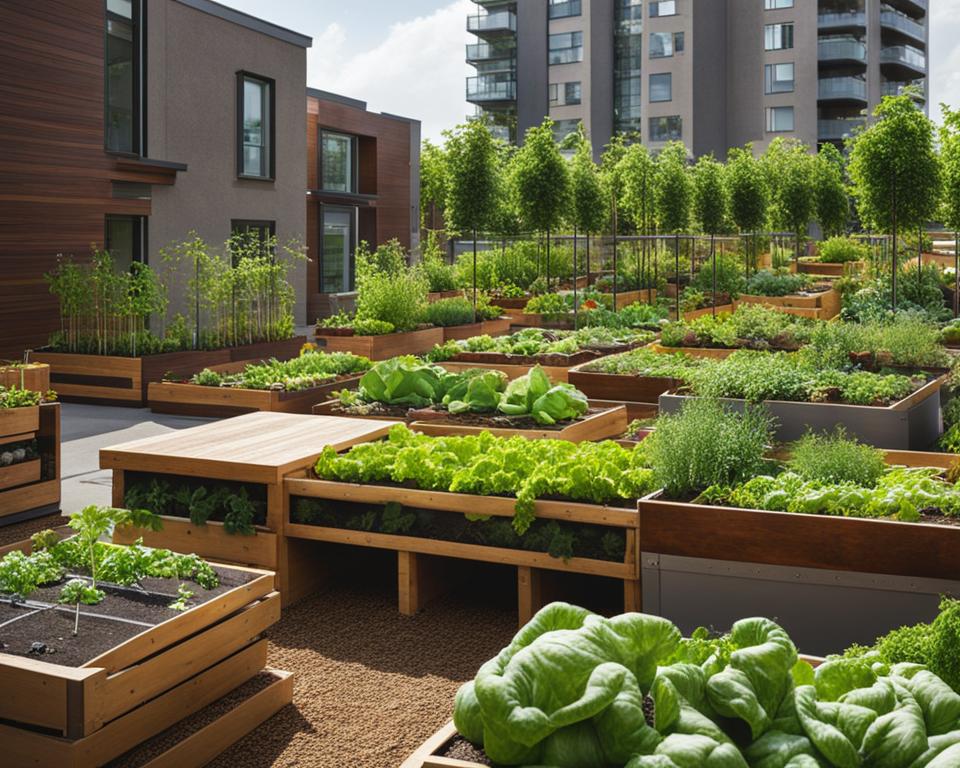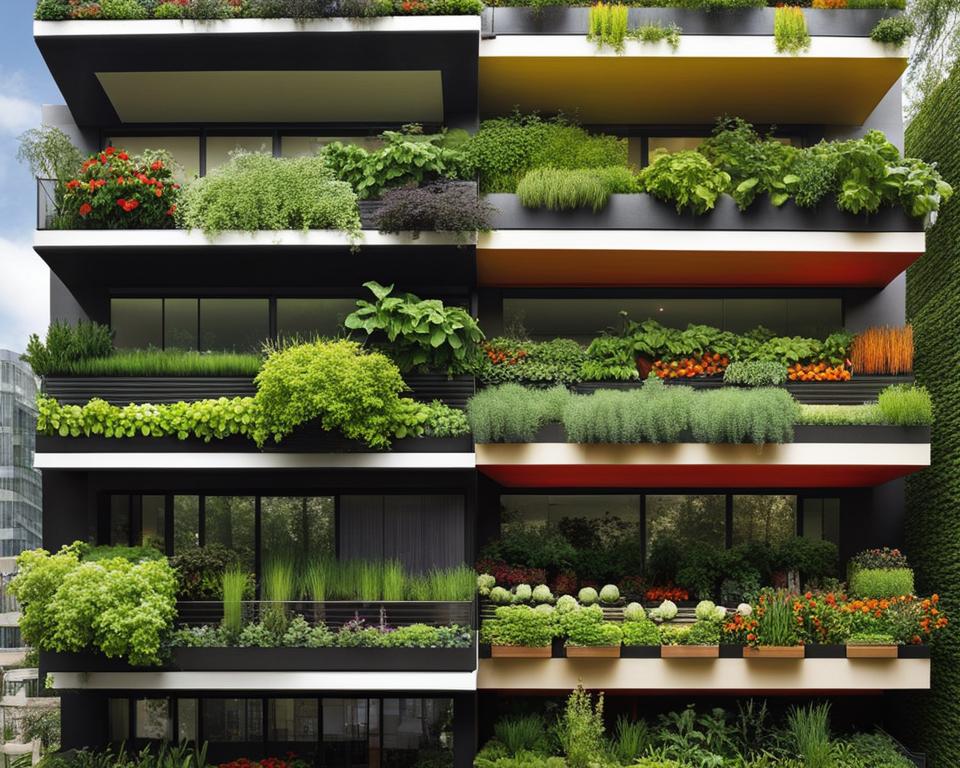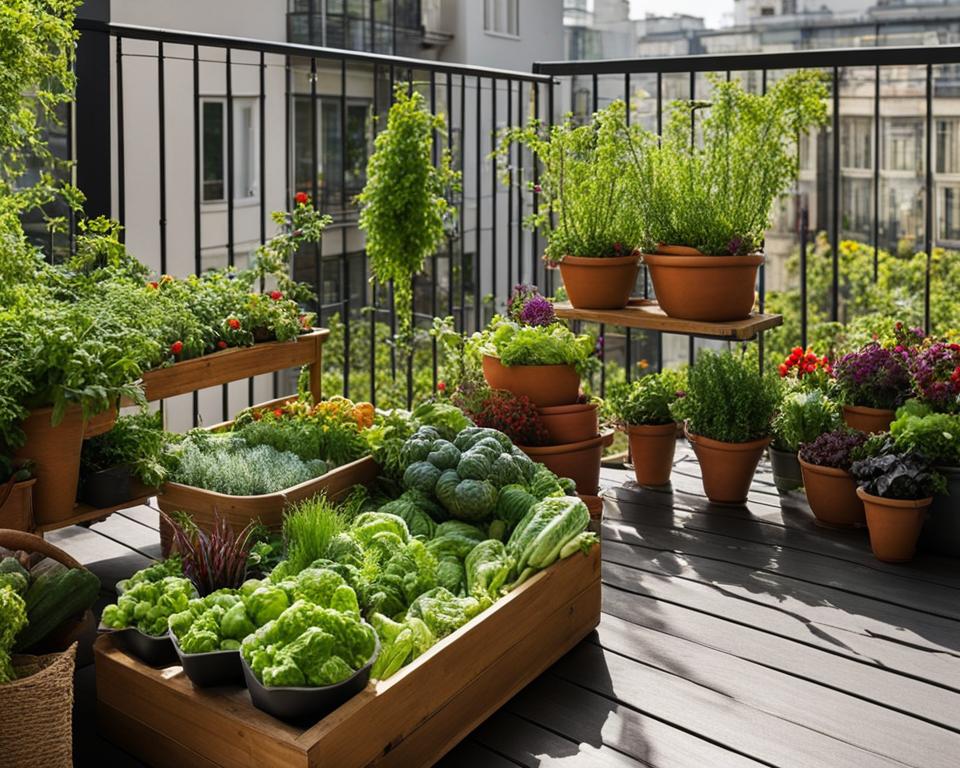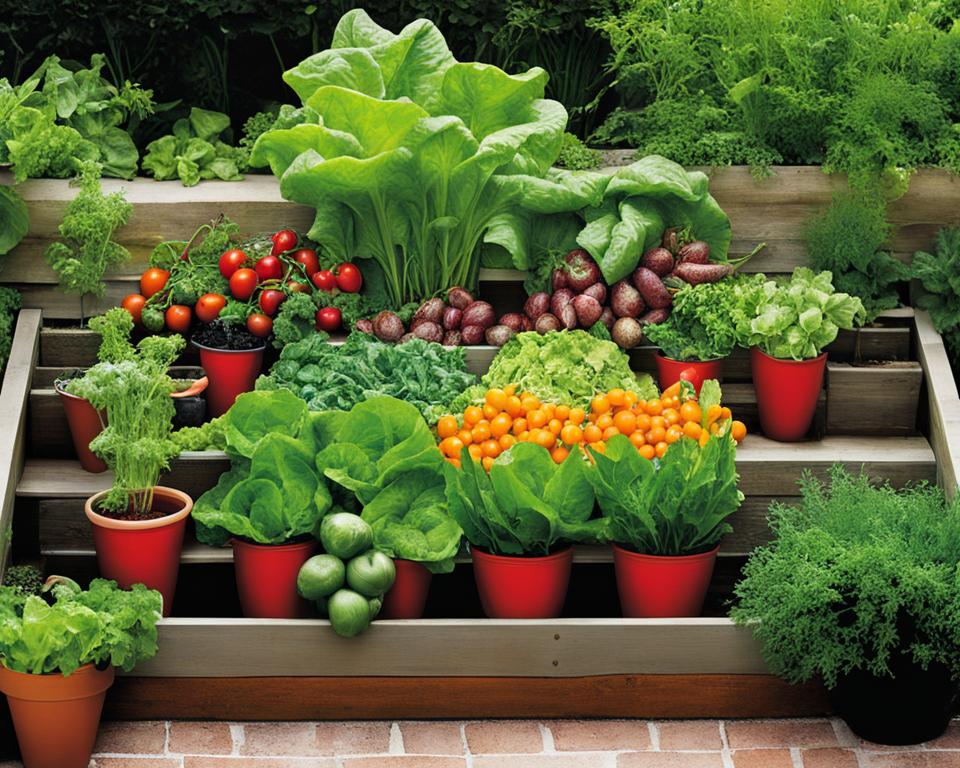Imagine transforming your urban living space into a lush, productive vegetable garden. With urban vegetable garden ideas at your fingertips, it is entirely possible and highly rewarding to grow your own food even in a concrete jungle. Edible landscaping allows you to cultivate delicious, fresh produce while enriching your city environment. Regardless of the size of your space – be it a tiny balcony or a modest backyard – you can create a thriving urban garden haven that not only nourishes your body but also feeds your soul.
Key Takeaways
- Urban vegetable garden ideas can transform even the smallest city spaces into productive gardens.
- Edible landscaping provides a sustainable and rewarding way to grow your own food in an urban setting.
- Small space vegetable gardening techniques can maximize limited areas for urban growers.
- Proper soil management, plant selection, and innovative methods are crucial to urban organic farming success.
- Vertical gardening and container gardening ideas help maximize space and yield in urban vegetable gardens.
- Rooftop and balcony gardens offer unique opportunities for cultivating edibles in high-rise buildings.
- Urban permaculture principles can create sustainable and self-sufficient ecosystems within city environments.
Maximizing Limited Spaces with Creative Urban Vegetable Gardens
Utilizing small spaces in urban environments can seem challenging, but with a touch of creativity and smart planning, it’s possible to achieve a bountiful harvest. This section will explore several urban gardening hacks, including optimizing vertical surfaces and selecting the perfect compact plant varieties for your urban vegetable garden ideas.
When it comes to small space vegetable gardening, every inch matters. Here are some key strategies to help you fully utilize the limited square footage available:
- Maximize vertical surfaces: One of the most effective ways to make the best use of small spaces is to leverage vertical spaces by using trellises, wall-mounted planters, and hanging baskets. This helps you create a visually appealing and space-saving garden.
- Choose compact plant varieties: Opt for smaller vegetable plant varieties that are specifically bred for their compact growth habits, such as dwarf tomato plants, mini bell peppers, or bush beans. These plants require less space, allowing you to cultivate more varieties in your urban garden.
- Utilize containers wisely: Select containers with varying heights and sizes and arrange them creatively to maximize their use. The mix of container sizes will not only save space but will also create an attractive display in your urban vegetable garden.
By applying these urban gardening hacks, even a small balcony, patio, or windowsill can be transformed into a verdant oasis that yields a surprising amount of fresh vegetables and herbs.
| Smart Plant Choices for Small Spaces | Plant Characteristics |
|---|---|
| Compact Tomato Varieties | Small in stature (under 3 ft.) but still produce abundant fruit |
| Mini Bell Peppers | Easily grown in containers and produce fruit size suitable for small space gardening |
| Bush Beans | Compact growth habit that requires minimal support structures |
| Dwarf Snap Peas | Short vines that produce tender pea pods, great for container gardening |
| Fingerling Eggplants | Small space-friendly eggplants that produce slim fruits |
To further enhance your small space garden, consider integrating companion planting to encourage natural pest control, improve pollination, and maximize the efficiency of your garden. For example, planting basil intermingled with tomatoes not only help repel pests but can also enhance the flavor of your tomatoes.
In conclusion, even the tiniest urban spaces can be transformed into a bountiful garden with the right mix of creativity, selection of plant varieties, and efficient utilization of vertical spaces. By incorporating these urban gardening hacks and small space vegetable gardening strategies, you’ll be able to enjoy the many benefits of cultivating your own urban vegetable garden.
The Essentials of Urban Organic Farming
Embracing urban organic farming not only provides you with fresh, chemical-free produce, but also fosters a healthier lifestyle and sense of community in city environments. This section will delve into the important aspects of urban organic farming that will help you create a thriving and sustainable urban vegetable garden.

Choosing the Right Soil and Fertilizers
High-quality soil is the foundation of any successful urban vegetable garden. Your choice of soil blend and organic fertilizers plays a crucial role in nurturing and nourishing your plants to ensure a bountiful harvest. Here are some tips on selecting the right soil and fertilizers for your urban organic farming endeavors:
- Opt for organic soil blends: To promote healthy plant growth, choose soil blends that are specifically designed for container gardening or raised beds. Look for organic mixes that contain a good balance of nutrients, beneficial microbes, and proper drainage capabilities.
- Consider creating your own soil blend: If you’re up for a DIY project, combine equal parts compost, peat moss or coco coir, and perlite or vermiculite. This custom blend will provide your plants with nutrients while allowing for proper airflow and moisture retention.
- Select organic fertilizers: Choose organic fertilizers that provide essential nutrients like nitrogen, phosphorus, and potassium. Popular options include worm castings, fish emulsion, and liquid seaweed. Remember to follow package instructions for proper application rates and methods.
Selecting Vegetable Varieties for Urban Conditions
When designing your urban vegetable garden, it’s essential to choose plant varieties that are well-suited for city environments. Consider plants that can thrive in circumstances such as limited space, shade, and exposure to pollution. Here are some suggestions to get you started:
Tip: Look for compact, dwarf, and bush varieties of your favorite vegetables to make the most of your small space.
| Category | Variety | Reason for Suitability |
|---|---|---|
| Tomatoes | Patio Princess, Window Box Roma | Compact plants that produce well in containers |
| Peppers | Dwarf Red Bell, Mohawk Sweet Pepper | Short, bushy plants that yield colorful, tasty fruits |
| Leafy Greens | Black Seeded Simpson Lettuce, Dwarf Blue Curled Kale | Hassle-free and relatively tolerant of shady conditions |
| Root Vegetables | Tonda di Parigi Carrots, Bambino Baby Beets | Small but flavorful, perfect for shallow containers |
| Herbs | Compact Dill, Boxwood Basil | Easily thrive in small pots and window boxes |
By choosing suitable vegetable varieties and nurturing them with the right soil and fertilizers, you can create a flourishing urban vegetable garden even in the heart of the city. Don’t be afraid to experiment and adapt your garden ideas to the unique challenges and rewards of urban organic farming.
Incorporating Vertical Gardening Tips into Your Urban Oasis
Vertical gardening is an essential technique for making the most out of small spaces in urban environments. By constructing and utilizing vertical garden structures like trellises and wall planters, you can create functional and beautiful additions to tiny balconies, patios, and walls. In this section, we will discuss some valuable vertical gardening tips to help you transform your small space vegetable gardening dreams into reality.
Vertical gardening is an art that allows you to grow more and save space by planting your vegetables, herbs, and flowers upwards.
- Select the right plants: Choose plants that naturally grow vertically, such as pole beans, peas, and cucumbers. You can also grow vining flowers like morning glory and clematis for added visual appeal and to attract beneficial insects.
- Utilize vertical supports: Install trellises, pergolas, or garden arches for your climbing plants, ensuring they are sturdy and well-anchored. To save more space and encourage air circulation, consider growing your plants in a fan or espalier pattern.
- Maximize wall space: Attach wall planters, hanging baskets, and vertical plant pockets to fences, exterior walls, or balcony railings to make the most of your available vertical surfaces. Ensure that they receive adequate sunlight and have proper drainage.
You can also explore other innovative urban vegetable garden ideas that promote vertical growth, such as using stackable planters, building pyramid gardens, or creating a recycled pallet garden.

Advantages of Vertical Gardening
Beyond saving space, vertical gardening offers several benefits to urban dwellers:
- Easier maintenance: Vertical gardens often require less weeding and watering compared to traditional beds, while also making tasks like pruning and harvesting more accessible.
- Improved plant health: Better air circulation and sunlight exposure for the plants help to reduce the incidence of pests and diseases.
- Enhanced visual appeal: Vertical gardens can disguise unsightly walls or fences, provide privacy, and add visual interest to your urban oasis.
Vertical Gardening Structures
There are various vertical garden structures to choose from, but some popular options include:
| Structure | Description |
|---|---|
| Trellises | Freestanding or attached to walls, trellises provide a framework for climbing plants, and come in various materials such as wood, metal, and plastic. |
| Wall Planters | Containers specifically designed to attach to walls or fences, which can be filled with soil and plants, and often come with built-in irrigation systems. |
| Vertical Plant Pockets | Fabric or felt pockets that hang on walls or other structures and hold small plants or herbs. They are lightweight, easy to install, and often modular. |
Vertical gardening is a practical and attractive way to maximize your urban vegetable garden potential. By implementing these tips and techniques, you can create an abundant and thriving garden oasis even in the smallest of spaces.
Container Gardening Ideas for Compact Living Areas

Container gardening opens up a world of possibilities for urban dwellers to grow fresh vegetables in their limited living spaces. With a variety of containers at your disposal, you can maximize your gardening potential while creating an aesthetically pleasing urban oasis. Explore the endless opportunities of container gardening to enhance your urban space and yield a bountiful harvest.
Utilizing Various Containers to Grow Vegetables
One of the most exciting aspects of container gardening is the variety of containers you can use to grow your vegetables. From simple pots and planters to more unconventional options like recycled items, window boxes, and tiered planters, there’s something for everyone’s taste and space constraints. Here are some creative container gardening ideas to inspire you:
- Recycled items: Old buckets, barrels, crates, or even boots can be repurposed as unique, eco-friendly planters. Make sure to drill drainage holes at the bottom to prevent waterlogging and root rot.
- Window boxes: Make use of your window sills with attractive window boxes filled with herbs, leafy greens, or compact vegetable varieties like cherry tomatoes, dwarf peppers, and radishes.
- Tiered Planters: Maximize your gardening space by stacking different levels of containers for a visually striking and space-efficient display of your favorite vegetable plants.
- Vertical Wall Planters: Transform your walls into productive growing spaces by installing wall-mounted planters filled with nutritious vegetables and herbs.
- DIY Pallet Planters: Repurpose wooden pallets into custom-designed, budget-friendly planters that can be tailored to your available space and preferred layout.
When selecting containers for your urban vegetable garden, be sure to consider factors such as size, material, drainage, and cost. Choose containers that are large enough to accommodate your plants’ root systems and offer adequate drainage to ensure healthy growth.
Pro Tip: Always make sure to drill drainage holes at the bottom of your repurposed containers. Good drainage is essential for preventing waterlogged soil and root rot, which can be detrimental to your plants’ health.
Maintaining your container gardens is crucial for your plants’ well-being and productivity. Here are some tips to keep your urban garden thriving:
- Water regularly: Container plants generally require more frequent watering due to the limited soil volume. Monitor the moisture levels in the soil and water when the top inch feels dry to the touch.
- Feed your plants: Regularly apply organic fertilizer or compost to provide your plants with the necessary nutrients for robust growth and high yields.
- Prune as needed: Regularly trim dead leaves, branches, and spent flowers to maintain plant health and air circulation, preventing diseases and pest infestations.
- Rotate crops: Rotating plants between containers helps break the lifecycle of pests and diseases and promotes overall garden health.
Incorporate these container gardening ideas and urban organic farming practices into your garden to make the most of your limited space, produce fresh, flavorful vegetables, and beautify your urban environment. With a little imagination and dedication, you can transform your compact living area into a thriving, green haven.
Rooftop Vegetable Garden: A Sky-High Haven for Urban Growers
As urban spaces continue to shrink, the concept of a rooftop vegetable garden is steadily gaining popularity among city dwellers seeking to incorporate sustainable and healthy practices into their lives. Edible landscaping on rooftops not only offers a unique gardening experience but also provides numerous benefits to both the gardeners and the environment. This section will discuss how rooftop gardens can transform underutilized spaces into thriving urban vegetable gardens.
“A rooftop garden isn’t just an attractive addition to your home; it’s an edible oasis in the middle of the urban jungle.”
One of the major advantages of having a rooftop vegetable garden is the availability of ample sunlight, which is essential for the growth of most vegetables. With proper planning and design, you can create an urban sanctuary that yields fresh produce, purifies the air, and provides a peaceful escape from the bustling city below.
- Assess the structural capacity: Before getting started, it’s crucial to determine if the building can support the weight of the garden. Consult a structural engineer or architect to ensure the safety and viability of your rooftop vegetable garden.
- Select suitable containers: Similar to other urban gardening methods, rooftop vegetable gardens primarily rely on container gardening. Opt for lightweight containers made from materials such as fiberglass or recycled plastic, which can effectively retain moisture and withstand harsh weather conditions.
- Choose the right plants: Be mindful of the plants you select for your rooftop vegetable garden. Opt for hardy varieties that can tolerate wind, heat, and full sun exposure. Some suitable options include tomatoes, peppers, beans, and leafy greens.
- Implement proper drainage and irrigation: Ensure proper drainage to avoid standing water which can damage the building structure and plant roots. Install an efficient drip irrigation system to provide consistent moisture without overwatering the plants.
- Plan for accessibility: Make your rooftop vegetable garden easily accessible, both for maintenance purposes and to create a welcoming space for relaxation and enjoyment. Consider adding appropriate seating areas and walkways to enhance the garden’s functionality.
While planning your rooftop vegetable garden, consider incorporating edible landscaping design elements that are not only productive but also visually appealing. Arranging plants in aesthetically pleasing patterns, mixing flowers with vegetables, and adding focal points such as trellises or water features can enhance the overall look and feel of your urban oasis.
| Vegetable | Special Considerations for Rooftop Gardens |
|---|---|
| Tomatoes | Choose determinate or patio varieties. Provide strong supports like cages or stakes. |
| Peppers | Select compact varieties. Provide occasional shade in extremely hot conditions. |
| Beans | Opt for bush bean varieties. Grow in large containers for adequate root space. |
| Leafy Greens | Grow in shallow containers. Provide shade cloth on hot days to avoid wilting. |
In conclusion, a rooftop vegetable garden is an excellent opportunity to repurpose underused urban spaces into productive, sustainable havens that benefit the environment and enhance your quality of life. With careful planning, design, and plant selection, you can create a stunning urban sanctuary that allows you to enjoy fresh produce right in the heart of the city.
Balcony Vegetable Garden: Cultivating Edibles in High-Rise Buildings
Living in high-rise buildings can sometimes limit your access to nature, but with some creativity, you can still enjoy the benefits of having your very own balcony vegetable garden. Despite the challenges, small space vegetable gardening is attainable and can be immensely rewarding. This section will discuss how to make the most of your balcony space, while also providing tips on container selection, water management, and maximizing limited sunlight for urban organic farming.
When starting your balcony vegetable garden, it is crucial to consider factors such as sunlight, weight restrictions, and wind exposure. Careful planning of your garden layout can ensure you grow healthy and productive crops even in compact spaces. Here are some tips to help you create a thriving balcony garden:
- Assess the sunlight your balcony receives during the day and plan your garden layout accordingly. Keep in mind that most vegetables need at least six hours of direct light daily to flourish.
- Select lightweight and durable containers suitable for your balcony or railing. Containers made of materials like plastic or resin offer more flexibility in terms of weight and positioning.
- Choose compact vegetable varieties that do well in containers, such as dwarf or bush varieties of tomatoes, peppers, and cucumbers.
- Utilize vertical space by installing trellises, hanging baskets, or vertical wall planters to grow climbing vegetables such as beans, peas, and tomatoes.
“In small space vegetable gardening, maximizing limited space is the key to success. Combine various container types, sizes, and designs to cultivate a diverse variety of edibles – ensuring both a visually appealing and productive balcony garden.”
Proper water management is essential in balcony vegetable gardens to prevent both over-watering and under-watering your plants. Implementing a drip irrigation system or self-watering containers can help maintain adequate moisture levels, reducing the risk of common watering issues in urban organic farming.
Overall, creating a balcony vegetable garden will not only help you enjoy fresh, homegrown produce but also transform your high-rise space into a green oasis. Start small and expand over time as you gain confidence and experience in small space vegetable gardening.
Urban Permaculture Principles to Reinvent Your Outdoor Space
Permaculture is a holistic approach to gardening that focuses on creating sustainable, self-sufficient ecosystems. By applying urban permaculture principles, you can transform your urban vegetable garden into a thriving oasis that maximizes space, improves soil health, and promotes biodiversity.
Designing Your Garden Using Permaculture Ethics and Principles
Permaculture ethics and principles serve as a guiding framework for designing an urban garden that promotes harmony with nature and fosters a closed-loop system, where waste is minimized and resources are efficiently utilized. Some key concepts to keep in mind when adapting your urban vegetable garden to permaculture principles include:
- Earth Care: Foster a healthy, vibrant garden environment by enriching your soil and creating diverse habitat.
- People Care: Consider the welfare of yourself, your community, and future generations by promoting a self-sufficient and sustainable food source.
- Fair Share: Share your garden’s bounty with your local community and use only the resources you need to minimize your ecological footprint.
When planning your garden, ensure that every element serves a purpose, contributing to the overall health and functionality of your urban ecosystem.
Implementing Permaculture Techniques for Sustainable Vegetable Yields
Integrating permaculture techniques into your urban vegetable garden can help you achieve sustainable vegetable yields and minimize your environmental impact. Here are a few strategies to incorporate into your urban garden:
- Companion Planting: Grouping plants with complementary characteristics together can enhance their growth, deter pests, and improve overall yields. For instance, planting marigolds alongside tomatoes can protect them from harmful nematodes, while basil wards off whiteflies.
- Creating Habitats for Beneficial Insects: Attract insects like ladybugs, bees, and lacewings to your garden by providing diverse habitat, such as flowering plants, shrubs, and mulch. These insects are crucial for pollination and natural pest control.
- Water Conservation: Implement water-saving techniques to minimize water usage. Use drip irrigation, rain barrels, and mulch to conserve water and maintain consistent moisture levels in your garden.
To successfully incorporate urban permaculture principles into your garden, continuously observe and interact with your garden environment, applying these techniques and making adjustments as needed. In doing so, you’ll cultivate a lush, sustainable ecosystem that will nurture and regenerate your garden while providing healthy, nourishing vegetables for years to come.
Embrace the Joys of Urban Vegetable Gardening
As we’ve explored throughout this article, there are a multitude of creative and innovative urban vegetable garden ideas that allow you to transform any small space into a thriving, edible landscape. From maximizing limited areas using vertical gardening techniques to implementing urban permaculture principles, these strategies encourage sustainable vegetable yields for fellow urban dwellers.
Embarking on your urban gardening journey offers numerous benefits, including improving your well-being and contributing to a greener, more sustainable future. Harvesting your own homegrown, organic produce not only provides a sense of accomplishment, but also contributes to a healthier lifestyle and community.
Take inspiration from this article and begin cultivating your urban oasis today. Remember that every small step towards urban farming helps shape a brighter and eco-friendly future, paving the way for a better urban living experience. So grab your gardening gloves, and unleash your creativity to bring your urban vegetable garden ideas to life!
FAQ
What are some space-saving urban vegetable garden ideas?
Some space-saving ideas include vertical gardening, container gardening, rooftop and balcony gardens, and utilizing permaculture principles to maximize efficiency within a small space.
Can I practice organic farming in an urban setting?
Yes, you can practice urban organic farming by choosing chemical-free, high-quality soil, selecting organic fertilizers, and opting for vegetable varieties that are well-suited for urban environments.
What is vertical gardening and how can it benefit my urban garden?
Vertical gardening is a technique that involves using vertical space,e.g., walls and trellises, to grow plants, thereby saving valuable floor space in urban gardens. It is beneficial as it allows for more efficient use of space, improves air circulation, and can serve as an aesthetic addition to any small garden area.
What are some container gardening ideas for compact living spaces?
You can use a variety of containers, such as window boxes, tiered planters, and even recycled items like old buckets and plastic bottles. These can be used to maximize your gardening potential while also serving as decorative elements in your urban space.
How can I create a rooftop vegetable garden?
To create a rooftop vegetable garden, assess the structural stability and weight capacity of the rooftop, choose appropriate containers, ensure proper drainage, and select plants that are suitable for rooftop conditions, such as those that can tolerate wind and sun exposure. Regular maintenance and proper watering will also be essential to the success of your aerial haven.
What are some tips for growing vegetables on a balcony?
For a successful balcony vegetable garden, select appropriate containers, manage water drainage effectively, make the most of available sunlight, and choose vegetable varieties that can thrive in limited space with potentially reduced sunlight and air exposure.
How can urban permaculture principles benefit my vegetable garden?
Urban permaculture principles can help you create a sustainable, self-sufficient vegetable garden by promoting harmony with nature, reducing ecological footprint, and enhancing biodiversity. Implementing permaculture techniques such as companion planting, creating habitats for beneficial insects, and conserving water can lead to sustainable vegetable yields and a healthier garden ecosystem.

